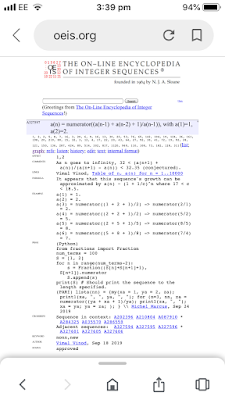The OEIS or the Online Encyclopedia of Integer Sequences holds pritty much all the important sequences known so far; So it was amazing when I was actually able to one of my own to the list in 18/09/2019!
They call they call my sequence { a(n) = numerator((a(n-1) + a(n-2) + 1)/a(n-1)), with a(1) = 1, a(2) = 2 } (Apparantly you can't call them pet names). Here are the first few terms:
1, 2, 2, 5, 8, 7, 16, 3, 20, 6, 9, 16, 13, 40,...
You can see more terms on their website (Click on the image). It's pritty complicated so any information on it will be appreciated.
What I know so far (All conjucture: you can prove it or disprove as you please):
1) The formula (1 + 1/c)^n approximates the growth of this sequence. As far as I have calculated 17.7 < c < 18.1 (If there is a c it is unlikely, on average to get higher that that).
2) (a(n+1) + a(n))/(a(n+1) - a(n)) = 32.2 (0.1 margin of error). Although it might be less clear, this is trying to show the change from a(n) to a(n+1). Which, with a bit of re-arranging looks like this: ((32.2 + 1)/(32.2 - 1))*a(n) = a(n+1). This led me to think about ((32.2 + 1)/(32.2 - 1) - 1)^(-1) because I expected it to be c or something close to it since they both describe the same thing. But its not; it equals 15.6 (0.05 margin of error).
If anyone has anything to add please comment down below.
They call they call my sequence { a(n) = numerator((a(n-1) + a(n-2) + 1)/a(n-1)), with a(1) = 1, a(2) = 2 } (Apparantly you can't call them pet names). Here are the first few terms:
1, 2, 2, 5, 8, 7, 16, 3, 20, 6, 9, 16, 13, 40,...
You can see more terms on their website (Click on the image). It's pritty complicated so any information on it will be appreciated.
What I know so far (All conjucture: you can prove it or disprove as you please):
1) The formula (1 + 1/c)^n approximates the growth of this sequence. As far as I have calculated 17.7 < c < 18.1 (If there is a c it is unlikely, on average to get higher that that).
2) (a(n+1) + a(n))/(a(n+1) - a(n)) = 32.2 (0.1 margin of error). Although it might be less clear, this is trying to show the change from a(n) to a(n+1). Which, with a bit of re-arranging looks like this: ((32.2 + 1)/(32.2 - 1))*a(n) = a(n+1). This led me to think about ((32.2 + 1)/(32.2 - 1) - 1)^(-1) because I expected it to be c or something close to it since they both describe the same thing. But its not; it equals 15.6 (0.05 margin of error).
If anyone has anything to add please comment down below.




